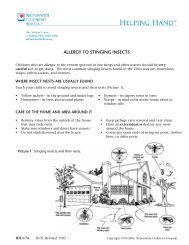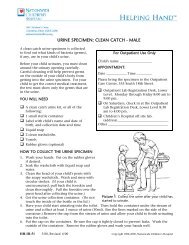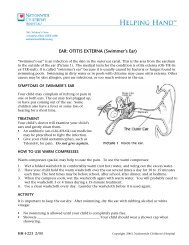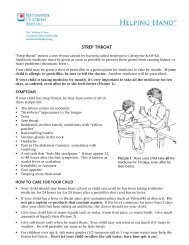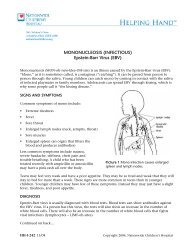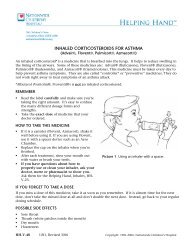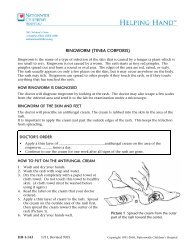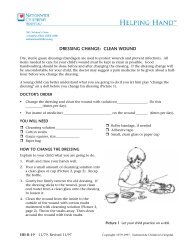Fever - Nationwide Children's Hospital
Fever - Nationwide Children's Hospital
Fever - Nationwide Children's Hospital
You also want an ePaper? Increase the reach of your titles
YUMPU automatically turns print PDFs into web optimized ePapers that Google loves.
FEVER<br />
<strong>Fever</strong> is an increase in the body’s temperature above the normal range. Body temperature can vary<br />
throughout the day, and may be different from one person to the next. It is hard to give an exact<br />
temperature for a fever, but most doctors agree that a temperature over 101˚ F is a fever.<br />
The body’s temperature is controlled by a part of the brain that acts as a thermostat. <strong>Fever</strong>s are caused<br />
when the thermostat is set higher than normal. This is usually in response to an infection from a<br />
virus or bacteria. It can also happen with heat exhaustion, extreme sunburn and other medical<br />
conditions.<br />
<strong>Fever</strong>s lower than 101˚ F do not need to be<br />
treated unless your child is uncomfortable or<br />
has a history of febrile seizures. Even higher<br />
temperatures are not typically dangerous unless<br />
there is a history of seizures or long-term<br />
illness. More important than the temperature<br />
is your child’s behavior. If your child is eating<br />
and sleeping well, is playful some of the time,<br />
and is comfortable, you may wait to see if the<br />
fever improves without treatment.<br />
HOME TREATMENT<br />
Picture 1 DO NOT give aspirin.<br />
• Dress lightly. While your child is sleeping<br />
cover with a sheet or light blanket.<br />
• Try to have your child drink extra fluids.<br />
• Your child can drink milk as normal, but solid food may be hard to digest. Do not worry if your<br />
child does not want to eat while there is a fever.<br />
• It is okay to let your child up out of bed, but she should play quietly and rest.<br />
• Medicines such as ibuprofen or acetaminophen can be used for fever higher than 101˚ F or if your<br />
child is uncomfortable. These medications are safe, effective ways to lower the fever.<br />
Acetaminophen (Tylenol®) may be used in all children over 2 months. Ibuprofen (Advil®,<br />
Motrin®) may be used in children over 6 months. Follow the package directions or talk to your<br />
doctor or pharmacist for dosing instructions. Do NOT give aspirin to children. Aspirin has been<br />
linked to a disease called Reye’s syndrome, which can be fatal.<br />
Caution: Medicines that reduce fever come in different strengths. Make sure you are using the<br />
correct strength before giving it to your child.<br />
WHEN TO CALL THE DOCTOR<br />
Call your child’s doctor immediately if your child has a fever and:<br />
• Is younger than 2 months of age and has a rectal temperature of 100.4˚ F or higher.<br />
• Looks very ill, is very fussy, or is hard to wake up.<br />
• Has been in an extremely hot place, such as an overheated car.<br />
HH-I-105 10/75 Revised 1/06<br />
Copyright 1975-2006, <strong>Nationwide</strong> Children’s <strong>Hospital</strong>
WHEN TO CALL THE DOCTOR, (Continued)<br />
<strong>Fever</strong> Page 2 of 2<br />
• Has a stiff neck, severe headache, severe sore throat, severe stomachache, unexplained rash, or<br />
repeated vomiting and diarrhea.<br />
• Has a condition that lowers immunity, such as sickle cell disease, cancer, or frequent oral steroid<br />
use<br />
• Has had a seizure.<br />
• Shows signs of dehydration – dry or sticky mouth, sunken eyes, not urinating.<br />
SPONGE BATHS<br />
Sponge baths may be used along with medicines to treat a fever over 104˚ F. Or sponge baths can be<br />
used to lower the temperature if your child is vomiting and cannot keep medicine down. Sponge<br />
baths usually start to work within 15 minutes.<br />
To give a sponge bath for a child that can be put in the bathtub:<br />
• Place your child in a bathtub with<br />
lukewarm (85˚- 90˚ F) water. Sponge water<br />
over his skin. Evaporation will help cool<br />
the skin and lower the fever.<br />
• If your child cannot sit in the bathtub, lay<br />
lukewarm wet washcloths on her stomach,<br />
groin, under the arms and behind the neck.<br />
• Do not use cold water to sponge your child.<br />
This is uncomfortable and could cause<br />
shivering. This can increase the<br />
temperature.<br />
• Do not add alcohol to the water. Alcohol<br />
can be absorbed into the skin or inhaled.<br />
This can cause serious problems, such as<br />
coma.<br />
• If your child struggles with the sponge<br />
bath, let him play in the water. If he still is<br />
upset, it is better to stop, even if the<br />
temperature is still high.<br />
Picture 2 Sponging with warm washcloths helps<br />
bring down a high fever.<br />
To give a sponge bath for a child that cannot be put in the bathtub:<br />
• Dip washcloths in warm – not hot, water and wring them out. Place washcloths on the child’s<br />
stomach, groin, under the arms, and behind the neck.<br />
• Change the washcloths as soon as they start to cool. The cool washcloths should be replaced with<br />
warm washcloths.<br />
• After 20 minutes, remove the washcloths and dry your child. Cover your child with a light<br />
blanket.<br />
• Wait 30 minutes and take your child’s temperature.<br />
• If the temperature is above 103˚ F or is going higher, repeat the sponging.



